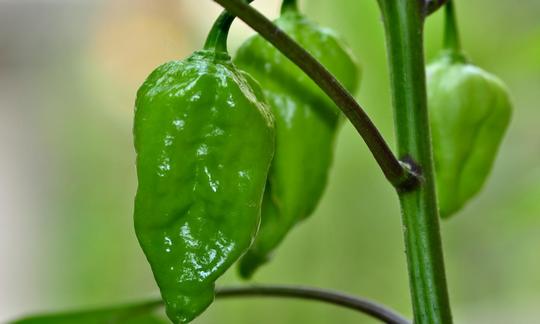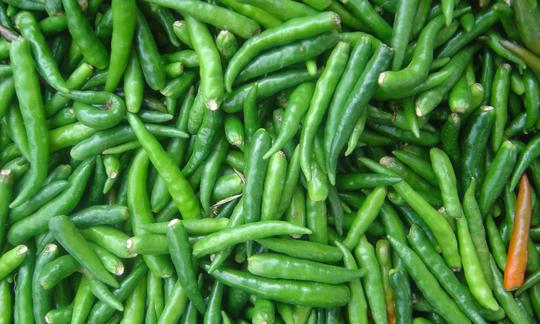Table of contents
Green chili peppers are used to make hot sauces or pastes, but can also be eaten raw or cooked. Make sure they are organic.
Use in the kitchen
Can you eat green chili? Various chilis are edible when green and ripe. These include varieties such as poblano, jalapeño, Thai chili, Tabasco and habaneros. Are there green chilis? Green chilis are harvested before they ripen to yellow, orange or red. They can be milder than fully ripe ones, but they don't have to be. Depending on the type, green chili peppers have their own properties and flavours, but are generally among the hotter types of pepper. They go well with many dishes and are used particularly in Italian, Creole and South American cuisine. But they are also very popular in Asian dishes such as curries (e.g. creamy vegetable curry with fresh ginger and cashews) or woks. They are used raw, dried or ground in various oils and sauces to spic up dishes. One of the best-known varieties is "Tabasco", which gives the Tabasco sauce its name. Similar to red chili peppers, green chili can be used in vegan stews such as chili sin carne, in soups (e.g. Cash-Mi soup with cashews, seaweed, ginger and turmeric), vegetable stir-fries, seasoning sauces or spice pastes (e.g. Laksa curry paste with fresh turmeric and ginger). It goes excellently with beans,corn, rice, noodles, tofu or other vegetables such as broccoli, carrots or tomatoes. Cut into thin rings, the green chili pepper can also be added raw to salads or used as a topping.
How hot a chili pepper is depends on various factors such as variety, ripeness, soil, climate, irrigation or time of harvest. 1 In addition, most of the spiciness is not in the flesh or seeds, but in the placental tissue inside, to which the seeds also attach. 1 Depending on whether you cook this with the pepper or cut it away beforehand, this influences the spiciness of the dish. If the food is too spicy, fatty foods (preferably plant-based), such as milk substitutes (e.g. oat drink), vegan cream ( sour cream, soy cream), vegan yoghurts or quark can reduce the spiciness.
Note: When working with chili peppers, it is recommended to wear gloves to avoid skin irritation. This is caused by the capsaicin contained in chili peppers. Since capsaicin is not water-soluble, if you are not wearing gloves you should wash it off your hands with oils/fats or alcohol and avoid touching your eyes or wounds with your hands beforehand.
Vegan recipe for salsa with green chili
Ingredients (for 4 people): 5 large tomatoes, 1 red bell pepper, 1 green bell pepper, 3 onions, 2 green chili peppers (organic), juice of 1 lemon, 2 tablespoons sugar, 1 tablespoon salt (level).
Preparation: Peel and finely chop the onions and garlic. Clean and wash the peppers and cut them into small cubes. Rinse the tomatoes and also chop them into small pieces. Cut the chili peppers into fine rings. Squeeze the lemon and collect the juice. Fry the onions and garlic in the pan. Once the onions are translucent, add the peppers and tomatoes and bring the mixture to the boil. Add the lemon juice and chili and simmer the salsa uncovered over medium heat for 1.5 hours, stirring occasionally. The salsa should reach a thick consistency as the liquid evaporates. Puree the mixture for a few seconds with a hand blender. Finally, season the salsa with salt and sugar. The spicy, vegan salsa tastes great warm with tortilla chips or chilled as a healthy spread on bread.
Vegan recipes with green chili peppers (raw) can be found under the note: " Recipes that have the most of this ingredient ".
| Not only vegans or vegetarians should read this: Vegans often eat unhealthily. Avoidable nutritional errors. |
Purchasing - Storage
The season for chili peppers lasts from July to October in Central Europe. Due to imports and greenhouse cultivation, fresh green chilies are available all year round in supermarkets such as Rewe, Coop and Migros. During the season, they can also be found at Denner, Volg, Spar, Aldi, Lidl, Rewe, Edeka, Hofer and Billa. There are also pickled varieties. Organic green chilies are available during the season at Denn's Biomarkt and Alnatura. Asian shops or online retailers are also good places to go. In many cases, however, it is not clear which variety is involved.
The availability of green chili peppers varies depending on the size of the store, catchment area, etc. Our recorded food prices for the DA-CH countries can be found above under the ingredient image - and by clicking on them you can see their development at various suppliers.
Storage tips
It is best to keep fresh chili peppers open in the refrigerator, as condensation and mold can form in closed containers. Chili peppers can also be frozen and thawed again when needed.
Ingredients - Nutritional values - Calories
Green chili peppers are particularly low in calories and have only 40 kcal per 100 g. This includes 0.2 g fat, 9.5 g carbohydrates and 2 g protein. 2 The nutritional values can vary depending on the variety.
100 g of green chili contains 242 mg of vitamin C (303% of the daily requirement). Guava has a similarly high amount of this vitamin (228 mg/100g). The vitamin C content varies considerably depending on the type of chili; the jalapeño variety (119 mg/100g), for example, contains only about half of this amount. Dried coriander leaves (567 mg/100g), for example, contain even more vitamin C than green chilis, although we usually consume much less of this. 2
Green chili peppers contain 0.28 mg of vitamin B6 per 100 g (20% of the daily requirement). Red bell peppers contain a similar amount of this vitamin (0.29 mg/100g). Red chili peppers (0.51 mg/100g) and Hungarian pointed peppers (0.52 mg/100g) contain almost twice as much. 2
Green chili contains 14 µg/100g of vitamin K (19% of the daily requirement). Artichokes (15 µg/100g) and cauliflower (16 µg/100g) contain a similar amount. Green bell peppers only contain about half of this amount (7.4 µg/100g). Kale (705 mg/100g) and spinach (483 mg/100g) contain significantly more of this vitamin. 2
The complete ingredients of green chili peppers (raw), the coverage of the daily requirement and comparison values with other ingredients can be found in our nutrient tables. In the article Nutrients explained you will get a detailed insight into the topic.
Health effects
Chili peppers are rich in vitamins, phytochemicals and carotenoids, which means they have numerous health benefits. The amounts contained vary depending on the variety, ripening process, time of harvest, handling after harvest, processing and storage. 3 Is green chili healthy? Green chili contains a number of health benefits. The high amounts of vitamin C and capsaicin are particularly noteworthy. Vitamin C has an antioxidant effect, captures free radicals and can thus help reduce the risk of coronary heart disease. 3
Capsaicin is an alkaloid found in bell peppers and chili peppers and is responsible for the perceived spiciness when consuming a food. It is characterized by anti-cancer, antimicrobial, antioxidant, diuretic, analgesic and anti-obesity properties. The amount of capsaicin is generally higher in red chilis than in green ones. 3 Is eating chili raw healthy? Eating raw chilis is generally preferable to roasting or frying, as heat greatly reduces or even completely removes the amounts of vitamins A and C contained in the chilis. 4
Dangers - Intolerances - Side effects
The German Federal Institute for Risk Assessment states that no health disadvantages are to be expected from the internationally usual consumption of chili peppers. The maximum accepted dose is 5 mg of capsaicin per body weight, which means 300 mg of capsaicin consumed in one meal for a person weighing 60 kg. Higher doses of capsaicin can, however, cause mucous membrane irritation, nausea, vomiting or high blood pressure. Caution is particularly advised with children, as serious poisoning can occur. 5
In addition, allergic reactions or intolerances can occur when eating nightshade plants. The allergy spectrum is individual and can change over time. 6 Cross allergies to birch pollen, grass pollen, cereal pollen or mugwort pollen can also develop. 6,7
Folk Medicine - Natural Medicine
Before chili peppers were used in cooking, they were most likely first used as medicinal plants. The Mayans used chili peppers to treat asthma, coughs and sore throats. In Colombia, the Tukano group ate chili peppers to cure hangovers. The Aztecs and Mayans mixed chili peppers with corn flour to make chillatolli, which they generally used to cure colds. The Teenek Indians (Huastec) in Mexico used chili peppers to treat infected wounds. Other uses include placing red, crushed fruits on the feet to cure athlete's foot and curing snake bites by making a drink from boiled green peppers. 8
Ecological footprint - animal welfare
The ecological footprint of a food depends on various factors. The type of agricultural production (conventional vs. organic), seasonal, regional or domestic production or import by truck, ship or plane, different types of packaging and whether the goods are fresh or frozen all play a decisive role. 9
According to a Danish calculation, chili peppers, like sweet peppers, have a CO 2 footprint of 0.96 kg CO 2 eq/kg. 17 A German study found a value of 0.6 kg CO 2 eq/kg for peppers. This means that the greenhouse potential is the same as for an average avocado. 9 The 'gPDF concept' for depicting biodiversity loss shows that these values do not take all factors into account:
ETH Zurich has measured the global loss of biodiversity due to land occupation of the products that are most commonly consumed in Switzerland. These include chili peppers (grouped together with paprika). Products from Sri Lanka are notable, with a biodiversity loss of 2.47 gPDF-eq/kg; compared to chilies and peppers from Spain, whose value is 0.05 gPDF-eq per kg. Low area yields in species-rich regions lead to high values here. The unit gPDFeq stands for "global fraction of potentially disappeared species" or the "impact of land occupation on global biodiversity". 18
The water footprint for 1 kg of green chilies (and peppers) is 379 litres. This puts chilies above the global average water consumption for vegetables (322 l/kg). 16
To improve understanding of the extent of the ecological footprint of chili peppers, one could compare the ecological footprint to the calories. Greenpeace has produced a poster for this: 0.755 kg CO 2 eq per ⅓ of the daily requirement for 1.333 kg of chili peppers. In reality, however, people only eat small amounts of chili peppers, which means that the ecological footprint is practically negligible. 19
For detailed explanations of various sustainability indicators (such as ecological footprint, CO2 footprint, water footprint), see our article: What does the ecological footprint mean?
Worldwide occurrence - cultivation
Green chili peppers are contained in the species C. annuum, C. frustescens and C. chinense. The varieties Poblano, Jalapeño, Serrano, Anaheim and African Bird-Eye belong to C. annuum, Thai chili and Tabasco belong to C. frutescens and the Habaneros variety belongs to the species C. chinense. The centre of all Capsicum species is in South America, although there is some certainty that C. annuum originates in Mesoamerica. The original area of C. frutescens and C. chinense is thought to be in the Amazon. 10 After Christopher Columbus discovered America, chili plants were brought to Europe. From there they spread all over the world, and are mainly grown in subtropical and temperate zones. The world's largest chili growing area is Mexico, followed by China, India and Indonesia. 11
Since there are countless varieties within the domesticated chili species and it is often not clearly declared in the trade which type of chili it is, it can certainly be confusing for the untrained eye.
Growing your own
Chili peppers can be grown in your own garden or greenhouse, or in a pot on the balcony. To do this, sow the seeds in a sowing substrate in February or March. Since chilis need warm climatic conditions to grow, sowing and pricking out under glass are necessary. At optimal temperatures of 25 to 28 °C, germination should begin within 10 to 30 days. This is best achieved with a mini greenhouse. At lower temperatures, the cultivation time is extended accordingly. If you want to grow chili peppers on the balcony, this is possible as soon as the temperature no longer falls below 5 °C. After that, a warm and sheltered location, in a sunny location, temperatures above 15 °C and at least 6-8 hours of sunshine per day are ideal. Commercially available sowing soil and vegetable soil are sufficient for the substrate. 12 With regular watering and fertilizing every two weeks, the fruit will ripen after about 120 days. However, the time of harvest varies depending on the variety. Good indicators of a ripe pod are a shriveled skin, a slight yielding of the flesh and possibly small black spots on the skin. 13 Black spots can also be a sign of mild sunburn.
Further information
Green chili belongs to the genus Capsicum and the nightshade family (Solanaceae). The genus Capsicum currently consists of 35 wild and 5 domesticated species ( Capsicum annuum, C. frutescens, C. chinense, C. baccatum and C. pubescens) 14, with an estimated 2500 to 3000 different chili varieties. 11 In colloquial language and in culinary terms, the chili fruit is referred to as a "pod". Botanically speaking, however, it is a berry. 8
The spiciness of the Capsicum genus is measured in so-called Scoville units. The classification on the Scoville scale depends on the capsaicin it contains. The spiciness is generally divided into mild (0-700 Scoville units), spicy (700-3000 Scoville units, e.g. sambal-Tabasco sauce), medium hot (3000-25,000 Scoville units, e.g. jalapeño), hot (25,000-70,000 Scoville units, e.g. serrano or cayenne pepper) and very hot (over 80,000 Scoville units, e.g. habanero). Pure capsaicin has a value of 15-16 million Scoville units. 3.15 But there are pepper varieties, such as the chili hybrid "Carolina Reaper", whose Scoville units even break the 2 million mark. 15
Alternative names
"Green chili" is a collective term for various types of chili that are harvested when they are green and ripe. People therefore often speak of the respective variety name, e.g. Jalapeño. These can then also be translated into English. If you want to use an English collective term, "green chili" or "green hot pepper" are suitable.
Bibliography - 19 Sources
| 1. | Vázquez-Espinosa M, Fayos O et al. Changes in capsiate content in four chili pepper genotypes (Capsicum spp.) at different ripening stages. Agronomy. 2020;10(9):1337. |
| 2. | USDA United States Department of Agriculture. |
| 3. | Hernández‐Pérez T, Gómez‐García M del R et al. Capsicum annuum (hot pepper): An ancient Latin‐American crop with outstanding bioactive compounds and nutraceutical potential. A review. Comp Rev Food Sci Food Safe. 2020;19(6):2972–2993. |
| 4. | Bashir O, Sharma V et al. Effect of roasting and frying treatments on aflatoxins and capsaicinoids content and nutritional profile of green chilies (Capsicum annum l.). Food Science & Nutrition. 2022;10(11):3672–3679. |
| 5. | Bfr.bund de: Zu scharf ist nicht gesund - Lebensmittel mit sehr hohen Capsaicingehalten |
| 6. | Gesundu de: Nahrungsmittelallergie auf Nachtschattengewächse. 2019. |
| 7. | Ernaehrung de: Nahrungsmittelallergien-Pollen. |
| 8. | Azlan A, Sultana S et al. Antioxidant, anti-obesity, nutritional and other beneficial effects of different chili pepper: a review. Molecules. 2022;27(3):898. |
| 9. | Reinhardt G, Gärtner S, Wagner T. Ökologische Fussabdrücke von Lebensmitteln und Gerichten in Deutschland. Institut für Energie- und Umweltforschung Heidelberg ifeu. 2020:1-22. |
| 10. | Clement C, De Cristo-Araújo M et al. Origin and domestication of native amazonian crops. Diversity. 2010;2(1):72–106. |
| 11. | Plantura garden: Chili: Alles Wissenswerte zum Pflanzen, Pflegen & Überwintern. |
| 12. | Gartenjournal net: Chili Pflanzen: Anbau, Pflege und Ernte leicht gemacht. 2023. |
| 13. | Gartenjournal net: Reife Chilis erkennen und richtig ernten: Tipps & Tricks. 2023. |
| 14. | Olatunji TL, Afolayan AJ. Evaluation of genetic relationship among varieties of Capsicum annuum L. and Capsicum frutescens L. in West Africa using ISSR markers. Heliyon. 2019;5(5):e01700. |
| 15. | Focus de: Scoville-Skala - So ist die Schärfe-Tabelle aufgebaut. 2017. |
| 16. | Mekonnen MM, Hoekstra AY. The green, blue and grey water footprint of crops and derived crop products. Hydrol. Earth Syst. Sci. 2011; 15: 1577-1600. |
| 17. | Concito. Denmark's green think tank. The big Climate Database. Version 1. |
| 18. | Zhiyenbek A, Beretta C, Stoessel F, et al. Ökobilanzierung Früchte- und Gemüseproduktion - eine Entscheidungsunterstützung für ökologisches Einkaufen. ETH Zürich. 2016. |
| 19. | Greenpeace Schweiz. All You Can Eat for climate - Poster. |













Comments